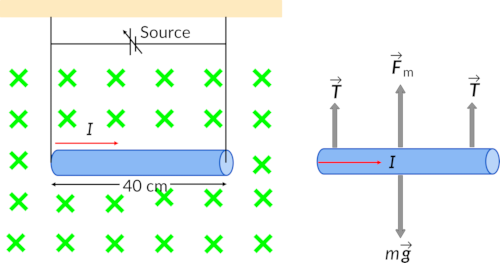28.8:
Magnetic Force On Current-Carrying Wires: Example
Consider a conductor in the XY plane carrying current to the left. The conductor consists of two straight segments with a length of L parallel to the x-axis and a semicircle with a radius of R.
If the conductor is placed in a uniform magnetic field perpendicular to the plane of the wire, pointing outward, determine the total magnetic force on the conductor.
Firstly, determine the magnetic force for the individual straight sections carrying current in the x direction.
Secondly, divide the curved segment into infinitesimal straight sections having a length of dl at an angle of theta.
The infinitesimal length and the magnetic field are perpendicular to each other, and the direction of their cross product is radially outward. So, the magnitude and components of the force on the sections can be determined.
By integrating the expression with respect to theta, the force on the whole curved conductor can be determined.
Finally, by adding the forces on all three sections, the total force on the conductor in the positive y direction can be obtained.
28.8:
Magnetic Force On Current-Carrying Wires: Example
In a magnetic field, moving charges encounter a force. If a wire contains these moving charges, i.e., if the wire is carrying a current, then a force acts on the wire as well. Consider a pair of flexible leads holding a wire that is 40 cm long and 10 g in weight in a horizontal position. The wire is placed in a constant magnetic field of 0.40 T, as shown in Figure 1(a). Determine the magnitude and direction of the current flowing in the wire needed to remove the tension in the supporting leads.
First, to solve the problem, draw a free-body diagram of the system, as shown in Figure 1(b). Second, use the right-hand rule to determine the direction of the magnetic force acting on the wire. Finally, equate the two forces to determine the current in the wire.

In a free-body diagram, the tension in the supporting leads is zero when the magnetic and gravitational forces are balanced. By using the right-hand rule, the magnetic force points up, and by equating the two forces of weight and magnetic force on the wire:
The current in the wire can be determined. The large magnetic field creates a significant force on a length of wire to counteract the weight of the wire.
Suggested Reading
- OpenStax. (2019). University Physics Vol. 2. [Web version], Pg 396 – 398. Retrieved from https://openstax.org/books/university-physics-volume-2@8ede2ba/pages/11-4-magnetic-force-on-a-current-carrying-conductor
